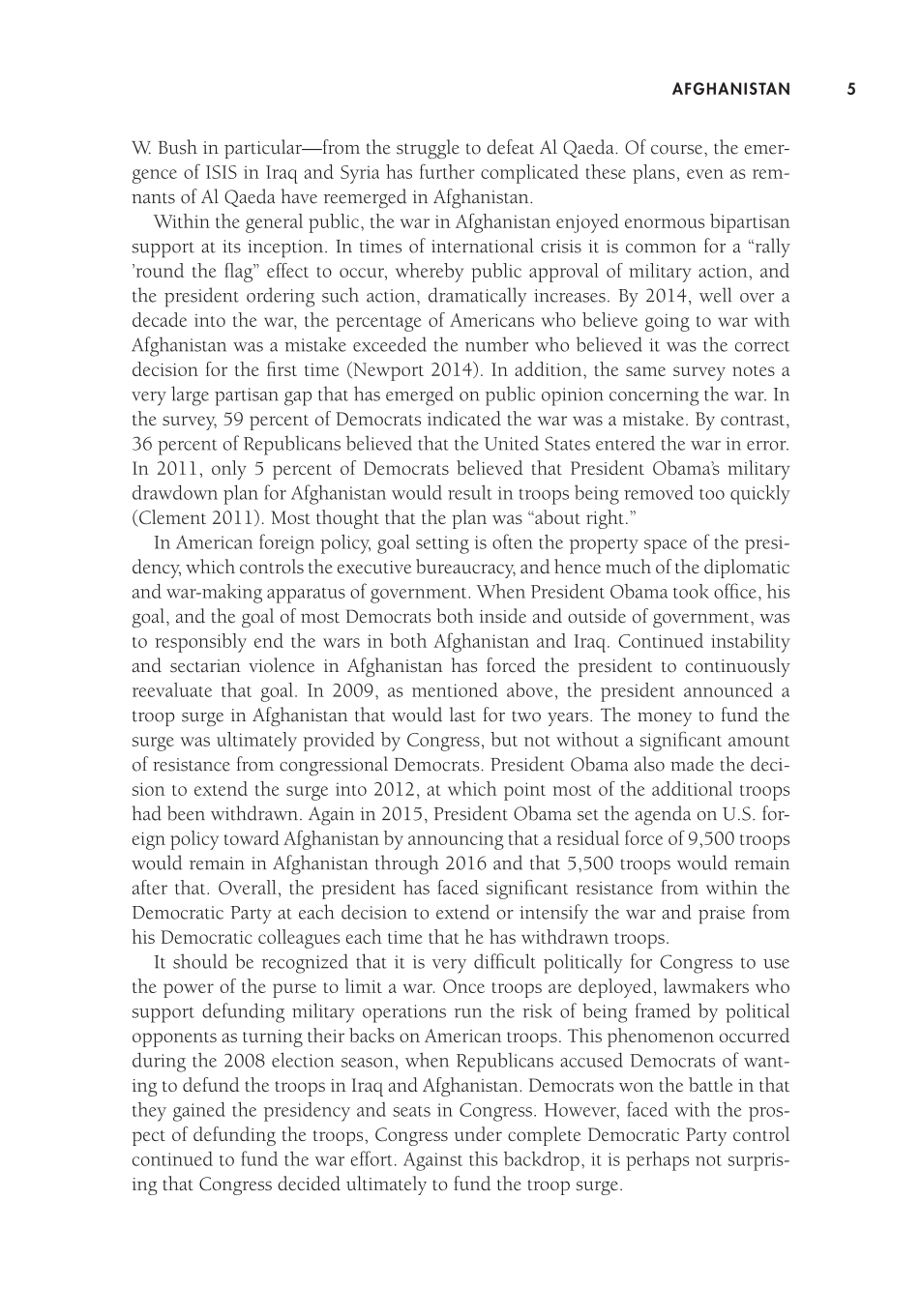Afghanistan 5
W. Bush in particular—from the struggle to defeat Al Qaeda. Of course, the emer-
gence of ISIS in Iraq and Syria has further complicated these plans, even as rem-
nants of Al Qaeda have reemerged in Afghanistan.
Within the general public, the war in Afghanistan enjoyed enormous bipartisan
support at its inception. In times of international crisis it is common for a “rally
’round the flag” effect to occur, whereby public approval of military action, and
the president ordering such action, dramatically increases. By 2014, well over a
decade into the war, the percentage of Americans who believe going to war with
Afghanistan was a mistake exceeded the number who believed it was the correct
decision for the first time (Newport 2014). In addition, the same survey notes a
very large partisan gap that has emerged on public opinion concerning the war. In
the survey, 59 percent of Democrats indicated the war was a mistake. By contrast,
36 percent of Republicans believed that the United States entered the war in error.
In 2011, only 5 percent of Democrats believed that President Obama’s military
drawdown plan for Afghanistan would result in troops being removed too quickly
(Clement 2011). Most thought that the plan was “about right.”
In American foreign policy, goal setting is often the property space of the presi-
dency, which controls the executive bureaucracy, and hence much of the diplomatic
and war-making apparatus of government. When President Obama took office, his
goal, and the goal of most Democrats both inside and outside of government, was
to responsibly end the wars in both Afghanistan and Iraq. Continued instability
and sectarian violence in Afghanistan has forced the president to continuously
reevaluate that goal. In 2009, as mentioned above, the president announced a
troop surge in Afghanistan that would last for two years. The money to fund the
surge was ultimately provided by Congress, but not without a significant amount
of resistance from congressional Democrats. President Obama also made the deci-
sion to extend the surge into 2012, at which point most of the additional troops
had been withdrawn. Again in 2015, President Obama set the agenda on U.S. for-
eign policy toward Afghanistan by announcing that a residual force of 9,500 troops
would remain in Afghanistan through 2016 and that 5,500 troops would remain
after that. Overall, the president has faced significant resistance from within the
Democratic Party at each decision to extend or intensify the war and praise from
his Democratic colleagues each time that he has withdrawn troops.
It should be recognized that it is very difficult politically for Congress to use
the power of the purse to limit a war. Once troops are deployed, lawmakers who
support defunding military operations run the risk of being framed by political
opponents as turning their backs on American troops. This phenomenon occurred
during the 2008 election season, when Republicans accused Democrats of want-
ing to defund the troops in Iraq and Afghanistan. Democrats won the battle in that
they gained the presidency and seats in Congress. However, faced with the pros-
pect of defunding the troops, Congress under complete Democratic Party control
continued to fund the war effort. Against this backdrop, it is perhaps not surpris-
ing that Congress decided ultimately to fund the troop surge.




























































































































































































































































































































































































































